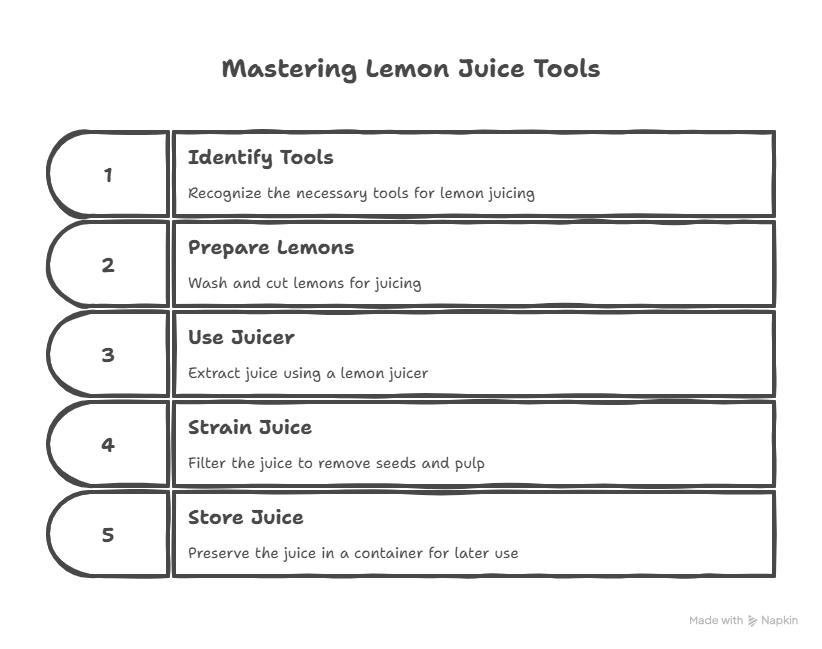
This document serves as a comprehensive guide for anyone looking to master the various tools used for extracting and utilizing lemon juice. Whether you are a culinary enthusiast, a professional chef, or simply someone who enjoys the refreshing taste of lemon, understanding the right tools and techniques can enhance your experience. From manual juicers to electric options, this guide will walk you through the essential tools, their uses, and tips for maximizing your lemon juice extraction. Here is a Step-by-Step Guide to Mastering Lemon Juice Tools.
Learn these Easy Steps to Juice Oranges Manually!
1. Understanding Lemon Juice Tools
Before diving into the specifics, it’s important to familiarize yourself with the different types of lemon juice tools available:
- Manual Juicers: These include handheld juicers, reamers, and citrus presses. They require physical effort but are often more affordable and easier to clean.
- Electric Juicers: These machines automate the juicing process, making it quicker and less labor-intensive. They are ideal for those who juice frequently.
- Zesters and Graters: While not directly for juicing, these tools help extract the zest, which can enhance the flavor of your dishes.
- Sifters and Strainers: Used to separate the juice from the pulp and seeds, ensuring a smooth consistency.
2. Choosing the Right Tool
Manual Juicers
- Handheld Juicer: Best for small quantities. Simply cut the lemon in half and press it into the juicer.
- Reamer: A simple tool that allows you to twist and extract juice by hand. Ideal for those who prefer a more hands-on approach.
- Citrus Press: Offers more leverage and can extract more juice with less effort. Look for one with a sturdy build for durability.
Electric Juicers
- Citrus Juicer: Perfect for frequent use, these machines can quickly juice multiple lemons with minimal effort.
- Slow Juicer: While primarily designed for a variety of fruits and vegetables, these can also juice lemons effectively, preserving more nutrients.
3. Step-by-Step Juicing Process
Step 1: Preparing the Lemons
- Choose fresh, ripe lemons. Look for ones that are firm and slightly heavy for their size.
- Roll the lemons on a countertop to break down the internal membranes, making juicing easier.
Step 2: Juicing
- Using a Manual Juicer: Cut the lemon in half and place it cut-side down in the juicer. Press down firmly and twist to extract the juice.
- Using an Electric Juicer: Cut the lemon in half and place it on the juicing cone. Turn on the machine and let it do the work.
Step 3: Straining the Juice
- Pour the juice through a fine mesh strainer or sifter to remove any pulp or seeds. This step is optional, depending on your preference.
Step 4: Storing the Juice
- Fresh lemon juice can be stored in an airtight container in the refrigerator for up to a week. For longer storage, consider freezing it in ice cube trays.
4. Tips for Maximizing Juice Extraction
- Warm the Lemons: If your lemons are cold, let them sit at room temperature for a while or microwave them for a few seconds to help release more juice.
- Use a Fork: If you don’t have a juicer, you can insert a fork into the lemon half and twist it to extract juice.
- Combine with Other Citrus: Mixing lemon juice with lime or orange juice can create a more complex flavor profile for your dishes.
Conclusion of Step-by-Step Guide to Mastering Lemon Juice Tools
Mastering lemon juice tools can significantly enhance your culinary skills and enjoyment of this versatile ingredient. By understanding the different tools available and following the step-by-step process outlined in this guide, you can efficiently extract lemon juice and elevate your recipes. Whether you’re making lemonade, marinades, or desserts, the right technique will ensure you get the most out of your lemons. Happy juicing!
Intrigued by what you’ve just learned? This is just the tip of the iceberg! Dive deeper and read the 6 Must-Have Features in a Lemon Juice Tool